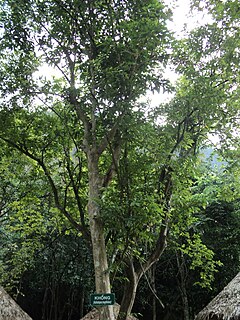
Antidesma is a genus of tropical plant in the family Phyllanthaceae formally described by Linnaeus in 1753. It is native to tropical Africa, S + E + SE Asia, Australia, and various oceanic islands. The greatest diversity occurs in Southeast Asia.
Paracroton is a genus of flowering plants in the Euphorbiaceae first described as a genus in 1859. It is native to South and Southeast Asia, as well as New Guinea.
- Paracroton integrifolius(Airy Shaw) N.P.Balakr. & Chakr. - Kerala, Tamil Nadu
- Paracroton pendulus(Hassk.) Miq. - India, Sri Lanka, Myanmar, Thailand, Malaysia, Borneo, Sumatra, Philippines
- Paracroton sterrhopodus(Airy Shaw) Radcl.-Sm. & Govaerts - W New Guinea
- Paracroton zeylanicus(Müll.Arg.) N.P.Balakr. & Chakr. - Sri Lanka
Wetria is a plant genus of the family Euphorbiaceae, first described as a genus in 1858. It is native to Australia, New Guinea and Southeast Asia.
- Wetria australiensisP.I.Forst. - Papua New Guinea, Queensland
- Wetria insignis(Steud.) Airy Shaw - Thailand, Myanmar, Peninsular Malaysia, Borneo, Sumatra, Java, Lesser Sunda Islands, Philippines
Spathiostemon is a genus of trees in the Euphorbiaceae family. It is native to the Bismarck Archipelago, New Guinea, Wallacea and Southeast Asia. The trees grow between 10 and 20m tall, often in secondary forest. The wood is sometimes used.
Rockinghamia is a plant genus of the spurge family (Euphorbiaceae), first described as a genus in 1966. The entire genus is endemic to the State of Queensland in Australia.
- Rockinghamia angustifolia(Benth.) Airy Shaw
- Rockinghamia brevipesAiry Shaw
Chondrostylis is a plant genus of the family Euphorbiaceae first described as a genus in 1897. It is native to Thailand, Peninsular Malaysia, Sumatra and Borneo.
- Chondrostylis bancanaBoerl. - Bangka, Kalimantan Tengah
- Chondrostylis kunstleri(King ex Hook.f.) Airy Shaw - S Thailand, W Malaysia, Borneo, Sumatra
Trigonopleura is a plant genus of the family Peraceae, first described as a genus in 1887. It is native to Indonesia, Malaysia, and the Philippines.
- Trigonopleura dubia(Elmer) Merr. - Philippines
- Trigonopleura macrocarpaAiry Shaw - Sarawak
- Trigonopleura malayanaHook.f. - Peninsular Malaysia, Sumatra, Bangka, Borneo, Sulawesi
Cheilosa is a monotypic plant genus of the family Euphorbiaceae first described as a genus in 1826. Only one species is recognized: Cheilosa montana, native to Southeast Asia.
Neoscortechinia is a plant genus of the family Euphorbiaceae first described as a genus in 1897. It is native to Southeast Asia and Papuasia.
- Neoscortechinia angustifolia(Airy Shaw) Welzen - Sabah, Kalimantan
- Neoscortechinia forbesii(Hook.f.) S.Moore - New Guinea, Admiralty Islands, Bismarck Archipelago, Solomon Islands
- Neoscortechinia kingii(Hook.f.) Pax & K.Hoffm. - W Malaysia, Sumatra, Borneo
- Neoscortechinia nicobarica(Hook.f.) Pax & K.Hoffm. - Nicobar Islands, Myanmar, Malaysia, Indonesia, Philippines, W New Guinea
- Neoscortechinia philippinensis(Merr.) Welzen - Myanmar, Thailand, Malaysia, W Indonesia, Philippines
- Neoscortechinia sumatrensisS.Moore - W Malaysia, N. Sumatra, Simeuluë, Borneo
Cleidiocarpon is a genus of plant of the family Euphorbiaceae first described as a genus in 1965. It is native to China and Indochina.
- Cleidiocarpon cavaleriei(H.Lév.) Airy Shaw - Yunnan, Guizhou, Guangxi, Vietnam
- Cleidiocarpon laurinumAiry Shaw - Thailand, Myanmar

Koilodepas is a genus of plant of the family Euphorbiaceae first described as a genus in 1856. It is native to Southeast Asia, India, Hainan, and New Guinea.
Cephalomappa is a genus of plant of the family Euphorbiaceae first described as a genus in 1874. It is native to Malaysia, Borneo, and Sumatra.
- Cephalomappa beccarianaBaill. - Sarawak
- Cephalomappa lepidotulaAiry Shaw - Malaysia, Borneo, Sumatra
- Cephalomappa malloticarpaJ.J.Sm. - Malaysia, Borneo, Sumatra
- Cephalomappa paludicolaAiry Shaw - Sarawak
- Cephalomappa penangensisRidl. - Peninsular Malaysia
Syndyophyllum is a plant genus of the family Euphorbiaceae, first described as a genus in 1900. It is native to Sumatra, Borneo, and New Guinea.
- Syndyophyllum excelsum K.Schum. & Lauterb. - New Guinea
- Syndyophyllum occidentale Welzen - Sumatra, Borneo
Blumeodendron is a genus of dioecious trees of the family Euphorbiaceae first described as a genus in 1873. It is widespread across much of Southeast Asia and Papuasia.

Endospermum is a genus of plants, under the family Euphorbiaceae and the monotypic subtribe Endosperminae first described as a genus in 1861 It is native to E + S + SE Asia, Papuasia, Queensland, and certain islands of the W Pacific.
Stachyandra is a plant genus in the family Picrodendraceae first described as a genus in 1990.

Breynia is a plant genus in the family Phyllanthaceae, first described in 1776. It is native to Southeast Asia, China, the Indian Subcontinent, Papuasia, Australia, and the island of Réunion.
Chorisandrachne is a genus of plants in the flowering plant family Phyllanthaceae first described as a genus in 1969. It contains only one known species, Chorisandrachne diplosperma, native to southern Thailand.

Hanguana is a genus of flowering plants with a dozen known species. It is the only genus in the family Hanguanaceae.
Choriceras is a genus of plants in the family Picrodendraceae first described as a genus in 1874.




